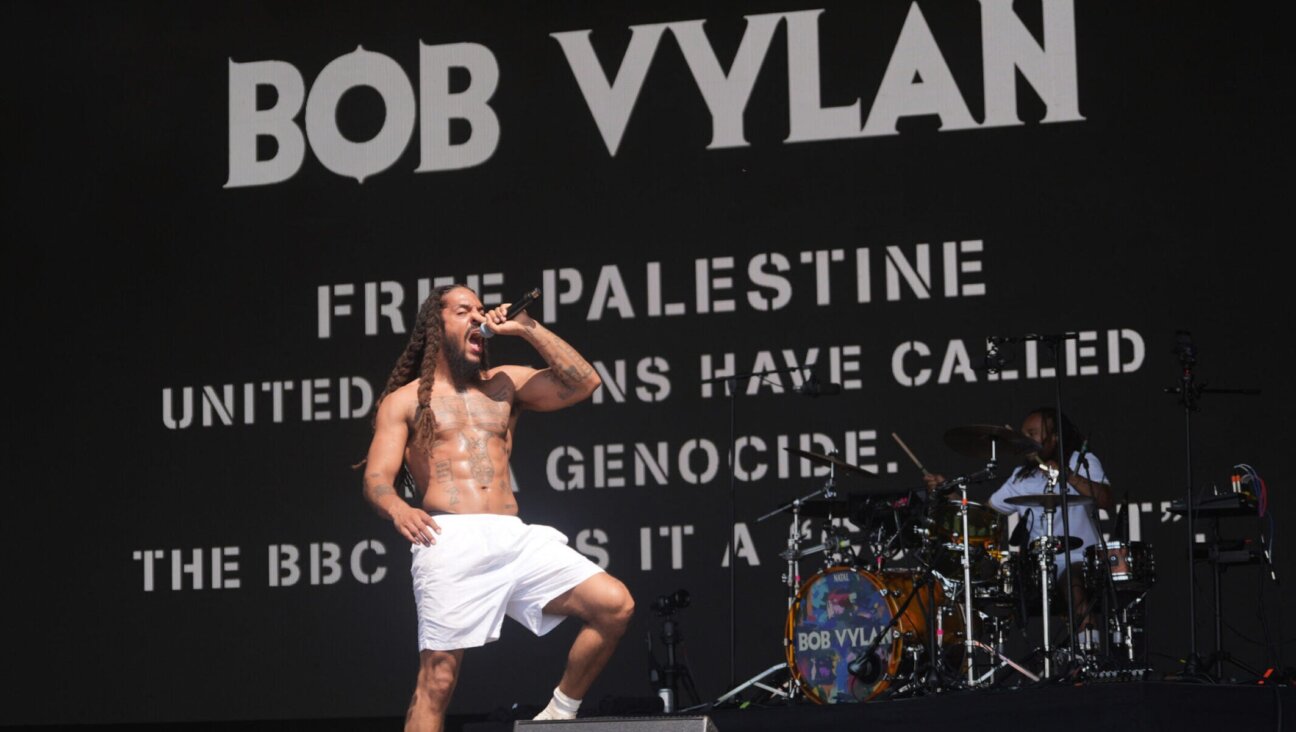How Jews Made London the Fashion Capital of the World

Image by Jewish Museum London
“Virtually every Jewish tailor was a showman,” reminisces Brian Bilgorri. His father, Harry (Sonny) Bilgorri, was owner of one of the most successful tailoring businesses in London’s East End, a contributor to the fashion revolution scene of the 1960s and one such showman.
In Sonny’s obituary, in 2001, The Independent newspaper described Bigorri’s as, “a meeting place for the famous, the infamous and the man about town.” Mark Feld (later Marc Bolan), as well as Mods and other iconic Sixties figures were customers. At that time, Brian tells me, a tailor’s shop was the place to go and hang out with your friends. Bilgorri’s was also popular among East End gangsters.
Bilgorri’s place in British men’s fashion history is just one of the stories highlighted in “Moses, Mods and Mr Fish: The Menswear Revolution,” the latest exhibition at Jewish Museum London. For over 100 years, British menswear set fashion trends that led the world and many of the most influential and innovative figures during this period were Jews. The exhibition charts the emergence of the modern male wardrobe — from the tailoring workshops of the mid 19th century and the start of the ready-to-wear industry to the boutique revolution and the British high street we know today. Among the eclectic selection of clothes on display is a 1966 mod suit, tailor-made by Sonny Bilgorri.
Jews have always been closely associated with the clothing trade. There are various theories as to why this is, says curator Elizabeth Selby, but the laws of kashrut and exclusion are significant factors. The religious prohibition against the mixing of wool and linen in garments, known as shatnez, meant that observant Jews had to make clothing for themselves. In the Pale of Settlement, one in four Jewish artisans was a tailor as a result of being subjected to exclusion from many other trades. The subsequent wave of immigration from Eastern Europe to Britain in the late 1880s brought thousands of tailors to the East End, as well as to Leeds in the north of England. By 1901, around 60% of London Jews were working in tailoring. Most eked a meager living yet, says Selby, for many immigrants there was a will and motivation to succeed.
One such immigrant was Lithuanian-born, Montague Burton who arrived in the UK in 1900, aged 15. By 1903, he had opened his first shop, initially selling ready-to-wear clothing — items created using a standardized set of measurements. A few years later, Burton was running three shops and a clothing factory in Leeds. He moved into producing made-to-measure suits, manufactured on a wholesale basis — the new system offering better value for his customers. Burton expanded rapidly and by 1939, there were 595 branches of his eponymous store across the UK, each with its eye-catching façade — the name Montague tucked across the swish of the large, ornate capital letter ‘B’ of Burton.
His success was not only due to astute business acumen. Burtons also had an effective marketing ploy. Broadcaster, writer and former customer, Michael Freedland recalls that almost every store had a billiard room at the back or in the basement. “They felt that young men, who were their chief market, would come in and play billiards and on the way out would order or buy a suit.”
War brought opportunity. During the Second World War, Burtons made a quarter of all service uniforms and post-war, a third of all demob suits. The term for these three-piece suits, ‘the full Monty,’ is a reference to his name. Another company, Moss Bros, took similar advantage of the wartime period. Moss Bros had initially made its name in the late 19th century by selling expensive clothes second hand, later opening a hire department. “Moss Bros became one of those brands just synonymous with a British way of life,” says David Moss, fifth generation of the Moss family to have been involved with the business, although it was sold some years ago. But crucially for many 13-year-old Jewish males, Moss Bros was where boys went with their fathers to buy their bar mitzvah suit.
By the late 1940s and 50s men’s fashion changed radically. Young men ceased to want to dress like their fathers and one of the first retailers to respond to this nascent youth market was another Lithuanian born tailor, Cecil Gee.
In 1946 he introduced his Hollywood inspired “American Look.” It was a contrast to the drabness of austerity that had gone before with its double-breasted broad shouldered suit jackets and painted ties. For the first time, a ready-to-wear suit was the height of menswear fashion and buyers queued around the block, as they sought to dress like screen idols, Clark Gable and Cary Grant.
Gee was the first entrepreneur to export clothing from Europe in the 1950s. In 1956, he pioneered the sharp, ‘Italian Look,’ which was later adopted by the Mods. Their archetypal style was a lightweight suit, with short single-breasted jackets and narrow trousers without turn-ups. Sixty years later, the slim fitting silhouette prototyped Top Man’s (formally Burtons) best-selling skinny suit – a 2015 version of which is on display.
Gee created an Italian scene in his shop, serving espressos to his clients and he even brought an Italian tailor over to London. His flagship central London store was located in the heart of the West End and close to Soho’s music clubs. In the centre of the shop was a huge cage filled with exotic birds whose song could be heard outside on the street. Gee kept a visitor’s book in the store – also on show – that he ensured was signed by anyone famous or well known. Danny Kaye, Frank Sinatra and Max Bygraves all have entries.

Image by Jewish Museum London
By the 1960s and early 1970s, London was the most exciting fashion capital in the world. Responding to the stylistic demands of its youth, an explosion of Jewish owned menswear boutiques sprang up in Carnaby Street — the shopping destination in Swinging Sixties London. Music and youth culture became intertwined as men came to listen to jazz or pop music as they browsed in shops that offered clothes that differed from the traditional merchandise. Every day was like a party, says Robert Orbach, co-owner of vintage boutique, I Was Lord Kitchener’s Valet whose clientele included Mick Jagger, Bob Dylan and Jimmy Page. “To be honest we were stoned a lot of the time so maybe it made it seem nicer than it was… [but] I never enjoyed going to work as much as I did in Carnaby Street because there was always something different going on.”
Nearby, in West London’s exclusive Mayfair, Mr Fish designed flamboyant clothes using high-end luxury fabrics, which became extremely popular among young aristocrats and celebrities including David Bowie and Mick Jagger. Michael Fish combined the skill and craftsmanship of traditional bespoke tailoring with more contemporary influences, using florals, frills and silks. Fish’s own dazzling brocade, Art Nouveau inspired jacket and turquoise trousers is on show. His wide, vibrant, trend setting ‘kipper’ ties – also seen here – are some of his best-known designs.
Despite its informative film footage the exhibition’s narrative is rather two-dimensional without the use of its superb audio app – the first commissioned by the Museum. It provides a more personal aspect to the stories behind the clothes, linking the tales of immigrant entrepreneurialism to the fashion trends of the second half of the last century.
Sourcing objects for Moses, Mods and Mr Fish was a long process, says Selby but her endeavors have paid off. From military and Mod wear, to John Lennon’s suede Cecil Gee jacket and a striking red 1970 Granny Takes a Trip suit, everyone, not just fashion aficionados, will find something to delight in.
Anne Joseph is a freelance writer based in the UK.























